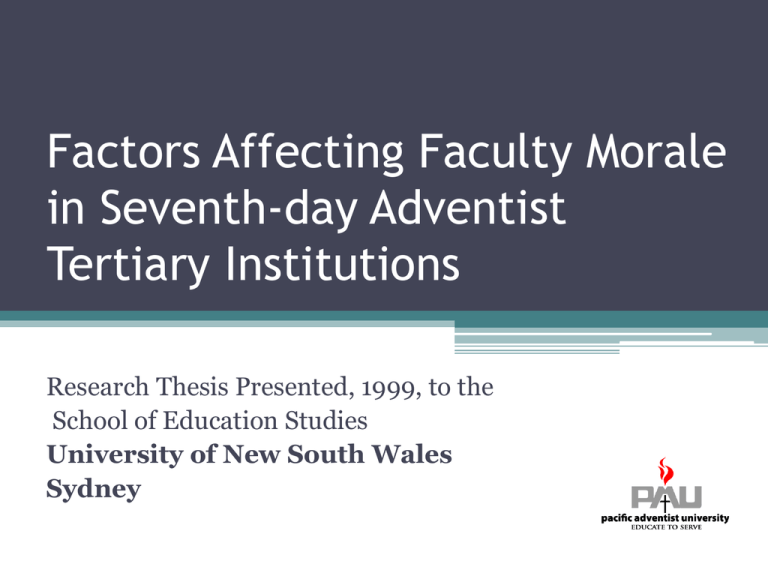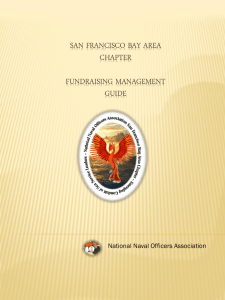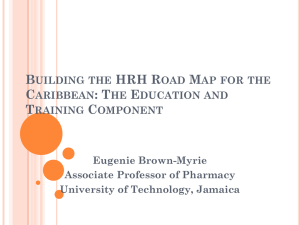Factors Affecting Faculty Morale in Seventh
advertisement

Factors Affecting Faculty Morale in Seventh-day Adventist Tertiary Institutions Research Thesis Presented, 1999, to the School of Education Studies University of New South Wales Sydney Using a multi-method approach, this study set out to examine the concept of faculty morale in the setting of the four South Pacific tertiary institutions owned and run by the Seventh-day Adventist (SDA) Church. Based on three research questions, the study was carried out in two stages representing the two models of research quantitative and qualitative. The study confirmed the multifaceted and complex nature of morale as well as the close relationship between this concept and that of job satisfaction. Definition Morale is the state of mind which predisposes a group (or individual) at a particular time, to view their leader/s, organization and its policies as contributing to, or thwarting their need satisfaction. The Issue of Faculty Morale • Faculty Morale in higher education has been the focus of numerous studies over the previous 30 years (prior to 1997), quite a few being very big. One of the biggest studies involved 20,000 faculty members in 14 countries in 6 continents. • However most of the colleges and universities in these studies had been large institutions, both public and private. • The size of these universities raises the important educational and sociological question about potential differences between large universities and small institutions in terms of faculty morale and the factors that affect it. For example, do the factors that affect faculty morale in large institutions operate in exactly the same manner for very small colleges and universities? Or are there factors inherent in small institutions that warrant studying them separately as far as faculty morale is concerned? As important as institutional size may be the question of church ownership of a college or university. Are there factors, for example, inherent in a church-owned and church-run institution that make them significantly, if not inherently, different from the much larger non-religiousbased institutions, both state and private, that have been the main subjects of various recent morale studies in higher education? • These questions gave rise to the need for the study. The term “higher education institutions” does not invoke a homogenous line-up of colleges and universities but a whole array of widely differing establishments. • These differences make if difficult and problematic to generalise the results of any one single-institution study (or even several institutions that belong to a single category). • It is these differences that give salience to this study which looks at faculty morale in four small tertiary institutions owned and operated by one Christian church denomination. • There is a dearth of material on faculty morale when it comes to church-owned and church-run institutions of higher learning. There is none on the morale of faculty in universities/colleges whose members all belong to the same church that runs the institutions. • This study attempts to fill this gap by presenting a snapshot of faculty morale in all four institutions owned and run by the Seventh-day Adventist Church in the South Pacific. These are institutions where 100% of the academic staff are also members of the SDA Church. Thus the Purpose of the Study was to examine, in the setting of SDA tertiary institutions in the South Pacific, the level of faculty morale and the relationship between faculty morale and a number of variables that might affect it. The literature reveals a close association between high morale and 3 factors: 1. High faculty involvement in institutional decision-making processes 2. A participatory leadership style on the part of senior administrators 3. A democratic organizational structure. Colleges with high morale had leaders who were “aggressively participatory”. Faculty members find that this leadership style is empowering and inspires trust. • The literature reported faculty dissatisfaction with the authoritarian management style, the “highcontrol style”, of a university leadership. • It also reports that faculty rebelled against an authoritarian style and the subordination of their personal dignity in order to increase production at lower costs. • It also cautioned that academics will “strongly resist being treated like factory workers” and pointed out the need to project more positive images of university leadership, alternatives to the “unilateral, top-down, command-and-control variety”. Research Questions Literature like the above raises important questions in relation to the four SDA tertiary institutions mentioned above. So this study set out to find answers to the following 3 research questions: Q1. What is the current state of faculty morale in the four SDA tertiary institutions under study? Research Questions Q2. What factors have contributed most to the current state of faculty morale in these institutions? a. To what degree is leadership style a major determinant of the current state of faculty morale? b. To what extent does institutional size make faculty more vulnerable/immune to morale issues? c. Does it make any difference to the morale equation that all administrators and faculty members are SDA Christians? d. Are there things in the SDA teachings and/or practices that tend to exacerbate or alleviate morale issues? e. To what extent does the faculty’s commitment to their church, or to God, or their patterns of shared experiences with the leader, override factors that would otherwise lead to dissatisfaction and low morale? f. Does the fact that they are church-owned, church-run institutions decrease or raise the levels of faculty stress in relation to workloads and other morale-related factors? Research Questions Q3. What elements could be changed in these institutions to improve faculty morale? Research Design In the quantitative-vs-qualitative debate there are purists, who would have nothing to do with the idea of combining the two approaches, and there are pragmatists, who see quantitative and qualitative methods as being able to inform one another, and in cooperation, combine their strengths to answer a research question more effectively. This study, adopting a pragmatist stance, is a combination of quantitative and qualitative research methods where the results of one approach guided and informed the development and implementation of the other. Target Population All 166 full-time faculty members at the four tertiary institutions owned and operated by the SDA Church in the South Pacific. Instrumentation The construction of the questionnaire for this study was based primarily on existing research and the current literature on morale. The literature, for example, reports that when members had a high regard for their organization, it follows that their morale is correspondingly high. In other words, members’ regard for their organization would be a good measure of the group’s morale. This helped this researcher in constructing at least one question which aimed at finding out how highly the respondents regarded their institution. The construction of other questionnaire items, in a similar way, adhered closely to the current literature. Having received the approval from the UNSW’s Ethics Committee, and the SDA education authorities, the final version of the questionnaire was mailed, along with a covering letter, an interview card, and a stamped return envelope, to all full-time members at the four institutions. The response rate was 63% and there were 50 interview cards mailed back separately at the expense of the respondents. In preparation for the development of interview schedules, the survey returns were initially analysed using descriptive statistics. Interview Questions (Example): My findings show that only 35% of College X respondents agreed that faculty morale was high. A similar percent (36%) agreed that the consultative process allowed at College X is appropriate; a similar percentage (34%) were satisfied with the level of faculty participation in the decision-making process at the College. Participation in decision-making seems connected to the morale of College X faculty. Do you agree? Why or why not? A fairly representative group, 33% of respondents, was interviewed, including at least one woman faculty member from each institution, a total of 8 women or 24% of the interviewees. This reflected closely the percentage of the respondents, 22%, who were women, and was not too different to the target population which was 25% women. Analysis The statistical analysis of the survey was carried out using the SPSS computer program. The qualitative data was analysed using a computer program called Ethnograph 4 The qualitative and quantitative data in this study complemented each other remarkably well, with the quantitative data giving the overall picture of faculty morale, and the qualitative data focusing in to provide a more in-depth examination of specific aspects of the morale of faculty, thus arriving at a more accurate evaluation of faculty morale at the 4 institutions. Findings While faculty morale appeared better in some institutions than others, the data reported in this study indicate that faculty morale overall seemed to have suffered due to a variety of factors. • Most notable among these was the perceived leadership style of senior administrators as manifested through a range of activities and attitudes comprising their willingness or otherwise * to share power with the faculty, * to follow a satisfactory process of consultation, * to allow adequate academic freedom, * to promote faculty participation and representation in institutional policy- and decision-making, and * to communicate openly with academic staff. When Leadership Style is seen to be appropriate and supportive of faculty and their work, Job Satisfaction, the second major factor that impacts on faculty morale, is also given a boost. A third major finding was the surprising noncorrelation between Faculty Morale and Commitment. Commitment, as understood by respondents in this study, refers, first and foremost, to their dedication and devotion to their Church, to God and His calling, as well as to their work, their students and to each other. The non-correlation between this religious commitment and morale seems to suggest that the two factors, while they may at times coincide, operate independently of each other much of the time. This may explain why many faculty members in SDA tertiary institutions are quite willing to continue working at their job despite what they themselves admit to be demoralising conditions. Size of institution did not emerge in this study as having an important relationship with faculty morale, either positively or negatively. However, from an examination of the responses to the four items that dealt with Size, it is clear that respondents generally regarded smallness of Size positively in regard to the issues of staff relationships, workloads, collegial support, and faculty harmony. To what extent does the faculty’s commitment to their church, or to God, or their patterns of shared experiences with the leader, override factors that would otherwise lead to dissatisfaction and low morale? Religious commitment appears to be a very powerful force in the life and work of SDA faculty members in the institutions involved in this study. However, rather than preventing low morale, commitment, as understood by SDA faculty members, acted as a “stand-by power pack” which kept faculty members going when motivation from high morale is low or non-existent. The following representative comments from interviewees make this point clear: I think commitment is something that pulls you through the hard times when morale is low. In spite of all the problems at the College, the faculty believe that they are serving God. This commitment to their God and the Church tends to transcend all the negatives around them. ....If it wasn’t for this commitment, I think it would have been a very different story. Although morale is low, we continue because we have that commitment to God. That’s the dedication of the staff to their mission despite the existence of factors that have brought about low morale. For me commitment to God and the Church is a very important factor. Without that commitment, my family and I would probably have quitted by now. Implications 1 If “the lives and work of faculty are central to institutional quality and students’ learning” (Austin, Rice and Splete: 1991, 153), if “the faculty is the heart of our institutions of higher learning” (Schuster and Bowen: 1985, 19), if “a university is its faculty” and “the excellence of a university is the excellence of its faculty” (Smith: 1978, 1), and, if “morale is regarded as a measure of the ‘health’ of an organisation” (Hunter: 1982, 95), then it behoves administrators in SDA tertiary institutions to do all within their power to improve faculty morale. Implications In the context of this investigation, this might mean listening to faculty and heeding their calls for greater participation in governance issues and other institutional decision-making processes. “Even in times of difficult decisions, morale will be bolstered by faculty involvement” (Olswang and Lee: 1984, 56). Implications 2 The data in this study seem to suggest the appointment of men (and women) who have, or are prepared to learn, the necessary skills for the improvement of faculty morale, men and women who can build trust rather than empires, men and women who can exercise authority not domination, those who are confident enough in themselves to empower others. SDA Church leaders in the South Pacific may find it advisable to have in-service training on these issues for some senior administrators in its tertiary institutions. Implications 3 Where morale is low, the behaviour of senior administrators may need to come under scrutiny. Morale problems may not require huge amounts of financial resources to rectify. However it will probably require a change of thinking and a change in the way people are treated and how things are handled. Implications for Faculty 1 Participation in governance issues and institutional decision-making inevitably takes time, time many faculty members may be unwilling to expend. However, if the joint involvement of faculty and administration in the governance processes is to be successful, faculty members must be willing and able to put in the necessary time. “Willingness” is a matter for staff themselves. “Ability”, on the other hand, may require supportive actions by the institutional leadership to enable staff members to contribute effectively to decision-making processes - through the provision of the necessary information and in-service training to make such participation effective, and, perhaps by a review of workloads to make it possible. Implications for Faculty 2. Involvement in the governing process also entails accountability. Faculty members who wish to be involved in the institution's governing or administrative processes must be willing to be held accountable for the consequences of their actions and decisions. Evidence from the current data suggests that faculty members are willing to accept this sort of responsibility which some SDA institutional administrators evidently are rather reluctant to give. Faculty morale and commitment The data in this study indicate that religious-oriented commitment is very sturdy, particularly in the three socalled mission-field institutions of the SDA Church. Despite this apparent vitality, however, only 3% of the current combined faculty at College B, College C and College D have remained in these institutions for 10 years or longer (compared to 64% at College A). The above low 3%, coupled with the high faculty turnover rate in these three institutions, speaks volumes about the limits of the effects of religious commitment in these institutions. There are implications in this for the SDA Church and its administrators. Final Word Successfully addressing morale-related issues raised in this report may not prove a panacea for all the problems of SDA tertiary institutions in the South Pacific. However, it would, more than likely, lead to a much happier staff, a condition which should bring about more positive results in terms of staff enthusiasm and productivity, as well as greater commitment to SDA tertiary institutions and their goals. Factors Affecting Faculty Morale in Seventh-day Adventist Tertiary Institutions Research Thesis Presented, 1999, to the School of Education Studies University of New South Wales Sydney







